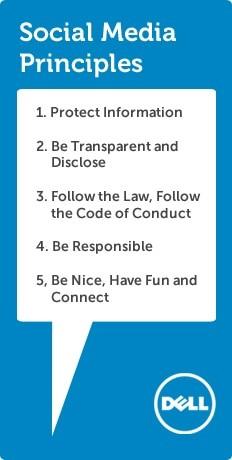Social media is an integral part of the digital marketing world. Social media platforms give brands a space to express themselves – making social media the public face of many companies.
However, the internet is a public and permanent space that does not forgive the trespasses of badly behaved brands. To avoid a scandal, brands need a social media policy to govern their use of social media.
[playht_player width=”100%” height=”175″ voice=”Mark”]
Do You Need a Social Media Policy?
A social media policy is a continuously updated document that guides your employees on appropriate social media use. Your policy does not control what your employees do on their personal accounts but provides guidance on how employees are expected to act when interacting with your brand publicly or managing your brand’s social media accounts.
Social media policies are a vital part of managing your brand’s public image, but many businesses are unaware that they need one.

Image via CarmineMastropierr
You should consider writing a social media policy if your brand satisfies one or more of these criteria:
- Your brand has a social media presence.
- Employees at your company use social media.
- Employees at your company list their employer in their profile.
- Customer service representatives use social media to speak with customers.
- Your brand appears in the media.
- Multiple people at your company run the brand’s social media accounts.
- Customers interact with your brand on social media.
- Senior members of your company are publicly known.
Importance of Social Media Policies
Although your employees may not intend to harm your brand, it is easy to publish content online that accidentally damages your brand’s reputation – often with permanent consequences.
While brands without any public presence can succeed with only a limited social media policy, failing to provide employees with proper governance on social media use can result in potential legal and public relations problems.
There are many benefits to having a social media policy for both digital marketers and other employees. Social media policies help digital marketers manage their brand’s social media accounts effectively, as they can:
- Help marketers develop content that is consistent with your brand’s values across all social media platforms.
- Prevent a public relations crisis.
- Help marketers create content that meets legal and regulatory requirements.
- Protect your brand’s accounts from cyber-attacks and account breaches.
- Give marketers step-by-step instructions on handling public relations issues on social media.
Social media policies help other employees draw the line between acceptable and unacceptable conduct on social media. Well-implemented policies can also teach good social media practices to employees without a digital marketing background, helping them enjoy social media while staying cyber secure.
Key Components of a Social Media Policy
Social media policies are living documents, meaning they need to be updated regularly as the culture of social media changes. Whether you are creating your first social media policy from scratch or re-doing your existing policy, here are the key components of a well-planned social media policy.
Section 1. Purpose and Value
Effective social media policies start with a clear statement explaining the purpose of the policy. This section makes it clear to employees what the policy covers, when the policy applies and how the policy will be enforced within your company.
The policy should cover a range of background information about your company’s digital marketing, including which digital marketing channels your brand uses. It should also explain how these are used to connect with customers and generate leads.
A brand’s social media policy applies in two essential circumstances, which should be made clear to employees in the ‘purpose’ section.
- Circumstance 1. Employees are operating brand-owned social media accounts.
- Circumstance 2. Employees are publicly interacting with the brand or representing the brand on their personal social media accounts.
When it comes to enforcing the policy, the document should make it clear what the consequences will be if an employee breaches the policy. This should include explaining what constitutes a breach of policy, and what consequences apply to small, medium, and large policy breaches.
The policy should also cover the principles your organization expects everyone to adhere to – like the principles laid out by Dell’s social media policy.

Image via Dell
Section 2. Employee Roles
In the ‘employee roles’ section, your social media policy should outline who is allowed to speak for your brand online, and who isn’t.
For employees who speak for your brand, the policy needs to make it clear what daily, weekly, and monthly responsibilities employees need to fulfill. Common responsibilities include:
- Filling the content calendar.
- Scheduling and publishing posts.
- Responding to reviews.
- Implementing paid-per-click (PPC) advertising.
- Managing crises.
- Daily customer service.
- Writing brand updates.
- Mapping customer journeys.
In this section, employees should be named individually, as this will make it easy for other members of the organization to contact them when needed.
For employees who do not work on your digital marketing, the policy should make it clear when they are allowed to engage publicly with the company. This includes whether they can tag the company, list it in their profile and include company property in posts.
Section 3. Security and Confidentiality
In this section, your social media policy should outline what security steps your brand is taking to ensure brand-social media accounts are not breached. Specifically, this section should explain:
- How frequently passwords need to be changed.
- Which people can have access to each account.
- Who can approve posts.
- How frequently organizational software is updated.
- Whether or not two-factor authentication is used.
- How the security of brand-owned social media will be assessed.
When a cybersecurity risk is spotted, this section should also explain how employees should handle the situation, and who to contact to escalate a concern.
Section 4. Compliance Regulations
This section of the report is designed to help employees understand how to use social media in accordance with local and federal laws. This includes three key concerns: copyright, privacy, and confidentiality.
Copyright
Copyright laws change in every jurisdiction, so your social media policy should outline what constitutes a breach of copyright in your area. To help employees stay compliant with copyright laws, your policy should make it clear how content on brand-owned accounts should be developed and assessed for uniqueness before publishing.
Privacy
In this part, your policy should make it clear how customer data is protected within your organization. This includes who can access and use customer data, who can contact customers.
Confidentiality
This section outlines how the confidentiality of your employees is protected, including when pictures of employees can be posted, how to obtain consent from an employee, and what information employees can post about each other.
Section 5. Handling PR problems
No matter how strong your company culture is, every brand is at risk of running into public relations problems. For this reason, your social media policy should explain how PR problems on social media are identified and managed.
There are two types of PR problems to consider in your policy: issues and crises. Issues are slowly-developing problems that threaten your brand’s reputation but can be resolved quickly. This includes negative reviews, customer complaints, and minor problems with products and services.
Crises, on the other hand, are large-scale problems that threaten your brand’s reputation and interrupt your daily operations. This includes situations where harm comes to an employee, bystander, or customer.
Employees can identify potential public relations problems by looking out for PR risks, which are situations in which your brand is not meeting customer expectations adequately.
Your social media policy should list potential PR risks, issues, and crises for your company, along with an explanation of what employees need to do in each situation. This should include who to contact, when to escalate concerns and when employees should raise concerns outside of business hours.

Image via Noggin
Section 6. Disclosing Company Information
In this section, your social media policy should make it clear what information employees can share about your brand, and what information must remain private.
For example, many social media policies allow employees to disclose what their position is and how long they have worked for the company, but do not permit employees to disclose:
- Any identifying information about customers.
- Information about their coworkers.
- Brand-secrets.
- Photos with company property.
- Locational data about the company’s operations.
- Non-public information about the brand.
Characteristics of a good social media policy
A well-implemented social media policy is designed to protect your brand and your employees on social media – but how do you know if you have a good policy?
Well-implemented social media policies are:
- written clearly, making them easy for everyone to understand.
- accessible to employees at any time.
- put into action alongside social media training.
- Updated at least yearly.
- Detailed, with examples explaining nuanced parts of the policy.
Your social media policy should also include a copy of your marketing key performance indicators (KPIs), as this will help employees understand how their behavior online contributes to the growth of the brand.
Create a social media policy
Building a strong social media policy doesn’t have to be tricky or time-consuming!
The best social media policies are based on current best practices, your brand’s current social media practices, and input from employees.
Having a firm social media policy in place can make all the difference for your digital marketing efforts, protecting them and boosting them at the same time.


